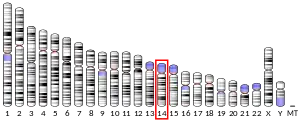Ribonuclease 4
Ribonuclease 4 is an enzyme that in humans is encoded by the RNASE4 gene.[5][6]
| RNASE4 | |||||||||||||||||||||||||
|---|---|---|---|---|---|---|---|---|---|---|---|---|---|---|---|---|---|---|---|---|---|---|---|---|---|
 | |||||||||||||||||||||||||
| |||||||||||||||||||||||||
| Identifiers | |||||||||||||||||||||||||
| Aliases | RNASE4, RAB1, RNS4, Ribonuclease 4, ribonuclease A family member 4 | ||||||||||||||||||||||||
| External IDs | OMIM: 601030 MGI: 1926217 HomoloGene: 10576 GeneCards: RNASE4 | ||||||||||||||||||||||||
| |||||||||||||||||||||||||
| |||||||||||||||||||||||||
| |||||||||||||||||||||||||
| Orthologs | |||||||||||||||||||||||||
| Species | Human | Mouse | |||||||||||||||||||||||
| Entrez | |||||||||||||||||||||||||
| Ensembl | |||||||||||||||||||||||||
| UniProt | |||||||||||||||||||||||||
| RefSeq (mRNA) | |||||||||||||||||||||||||
| RefSeq (protein) | |||||||||||||||||||||||||
| Location (UCSC) | Chr 14: 20.68 – 20.7 Mb | Chr 14: 51.09 – 51.11 Mb | |||||||||||||||||||||||
| PubMed search | [3] | [4] | |||||||||||||||||||||||
| Wikidata | |||||||||||||||||||||||||
| |||||||||||||||||||||||||
The protein encoded by this gene belongs to the pancreatic ribonuclease family. It plays an important role in mRNA cleavage and has marked specificity towards the 3' side of uridine nucleotides.
Alternative splicing results in two transcript variants encoding the same protein. This gene and the gene that encodes angiogenin share promoters and 5' exons. Each gene splices to a unique downstream exon that contains its complete coding region.[6]
References
- GRCh38: Ensembl release 89: ENSG00000258818 - Ensembl, May 2017
- GRCm38: Ensembl release 89: ENSMUSG00000021876 - Ensembl, May 2017
- "Human PubMed Reference:". National Center for Biotechnology Information, U.S. National Library of Medicine.
- "Mouse PubMed Reference:". National Center for Biotechnology Information, U.S. National Library of Medicine.
- Rosenberg HF, Dyer KD (Jan 1996). "Human ribonuclease 4 (RNase 4): coding sequence, chromosomal localization and identification of two distinct transcripts in human somatic tissues". Nucleic Acids Res. 23 (21): 4290–5. doi:10.1093/nar/23.21.4290. PMC 307382. PMID 7501448.
- "Entrez Gene: RNASE4 ribonuclease, RNase A family, 4".
Further reading
- Shapiro R, Fett JW, Strydom DJ, Vallee BL (1987). "Isolation and characterization of a human colon carcinoma-secreted enzyme with pancreatic ribonuclease-like activity". Biochemistry. 25 (23): 7255–64. doi:10.1021/bi00371a002. PMID 3467790.
- Seno M, Futami J, Tsushima Y, et al. (1995). "Molecular cloning and expression of human ribonuclease 4 cDNA". Biochim. Biophys. Acta. 1261 (3): 424–6. doi:10.1016/0167-4781(95)00040-n. PMID 7742370.
- Zhou HM, Strydom DJ (1993). "The amino acid sequence of human ribonuclease 4, a highly conserved ribonuclease that cleaves specifically on the 3' side of uridine". Eur. J. Biochem. 217 (1): 401–10. doi:10.1111/j.1432-1033.1993.tb18259.x. PMID 8223579.
- Egesten A, Dyer KD, Batten D, et al. (1997). "Ribonucleases and host defense: identification, localization and gene expression in adherent monocytes in vitro". Biochim. Biophys. Acta. 1358 (3): 255–60. doi:10.1016/S0167-4889(97)00081-5. PMID 9366257.
- Terzyan SS, Peracaula R, de Llorens R, et al. (1999). "The three-dimensional structure of human RNase 4, unliganded and complexed with d(Up), reveals the basis for its uridine selectivity". J. Mol. Biol. 285 (1): 205–14. doi:10.1006/jmbi.1998.2288. PMID 9878400.
- Xu XR, Huang J, Xu ZG, et al. (2002). "Insight into hepatocellular carcinogenesis at transcriptome level by comparing gene expression profiles of hepatocellular carcinoma with those of corresponding noncancerous liver". Proc. Natl. Acad. Sci. U.S.A. 98 (26): 15089–94. doi:10.1073/pnas.241522398. PMC 64988. PMID 11752456.
- Strausberg RL, Feingold EA, Grouse LH, et al. (2003). "Generation and initial analysis of more than 15,000 full-length human and mouse cDNA sequences". Proc. Natl. Acad. Sci. U.S.A. 99 (26): 16899–903. doi:10.1073/pnas.242603899. PMC 139241. PMID 12477932.
- Ota T, Suzuki Y, Nishikawa T, et al. (2004). "Complete sequencing and characterization of 21,243 full-length human cDNAs". Nat. Genet. 36 (1): 40–5. doi:10.1038/ng1285. PMID 14702039.
- Gerhard DS, Wagner L, Feingold EA, et al. (2004). "The status, quality, and expansion of the NIH full-length cDNA project: the Mammalian Gene Collection (MGC)". Genome Res. 14 (10B): 2121–7. doi:10.1101/gr.2596504. PMC 528928. PMID 15489334.
- Rual JF, Venkatesan K, Hao T, et al. (2005). "Towards a proteome-scale map of the human protein-protein interaction network". Nature. 437 (7062): 1173–8. doi:10.1038/nature04209. PMID 16189514.
This article is issued from Wikipedia. The text is licensed under Creative Commons - Attribution - Sharealike. Additional terms may apply for the media files.





